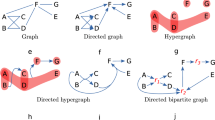Abstract
This paper describes a polynomial time algorithm HAM that searches for Hamilton cycles in undirected graphs. On a random graph its asymptotic probability of success is that of the existence of such a cycle. If all graphs withn vertices are considered equally likely, then using dynamic programming on failure leads to an algorithm with polynomial expected time. The algorithm HAM is also used to solve the symmetric bottleneck travelling salesman problem with probability tending to 1, asn tends to ∞.
Various modifications of HAM are shown to solve several Hamilton path problems.
Similar content being viewed by others
References
D. Angluin andL. G. Valiant, Fast probabilistic algorithms for Hamilton circuits and matechings,J. Computer Syst. 18, (1979), 155–193.
B. Bollobás, Almost all regular graphs are Hamiltonian,European Journal of Combinatorics 4, (1983), 311–316.
B. Bollobás,Random Graphs, Academic Press, London, (1985).
B. Bollobás andA. M. Frieze, On matchings and Hamilton cycles in random graphs,Annals of Discrete Mathematics,28 (1985), 23–46.
P. Erdős andA. Rényi, On the strength of connectedness of a random graph,Acta. Math. Acad. Sci. Hungar. 12, (1961), 261–267.
T. I. Fenner andA. M. Frieze, On the existence of Hamilton cycles in a class of random graphs.Discrete Mathematics 45, (1983), 301–305.
A. M. Frieze, Limit distribution for the existence of Hamiltonian cycles in a random bipartite graph,European Journal of Combinatorics,6 (1985), 327–334.
Y. Gurevich andS. Shelah, Technical Report of the University of Michigan, 1985.
M. Held andR. M. Karp, A dynamic programming approach to sequencing problems,SIAM Journal on Applied Mathematics 10, (1962), 196–210.
M. Komlós andE. Szemerédi, Limit distribution for the existence of a Hamilton cycle in a random graph,Discrete Mathematics 43, (1983), 55–63.
R. M. Karp andJ. M. Steele, Probabilistic analysis of the travelling salesman problem, inThe Travelling Salesman Problem: A Guided Tour (E. L. Lawler, J. K. Lenstra, A. H. G. Rinnoy-Kan and D. B. Shmoys, eds), John Wiley and Sons (1985).
E. Shamir, How many edges are needed to make a random graph Hamiltonian?Combinatorica 3, (1983), 123–132.
A. G. Thomason, A simple linear expected time algorithm for Hamilton cycles, to appear.
Author information
Authors and Affiliations
Additional information
Supported by NSF Grant MCS 810 4854.
Rights and permissions
About this article
Cite this article
Bollobás, B., Fenner, T.I. & Frieze, A.M. An algorithm for finding hamilton paths and cycles in random graphs. Combinatorica 7, 327–341 (1987). https://doi.org/10.1007/BF02579321
Received:
Revised:
Issue Date:
DOI: https://doi.org/10.1007/BF02579321




